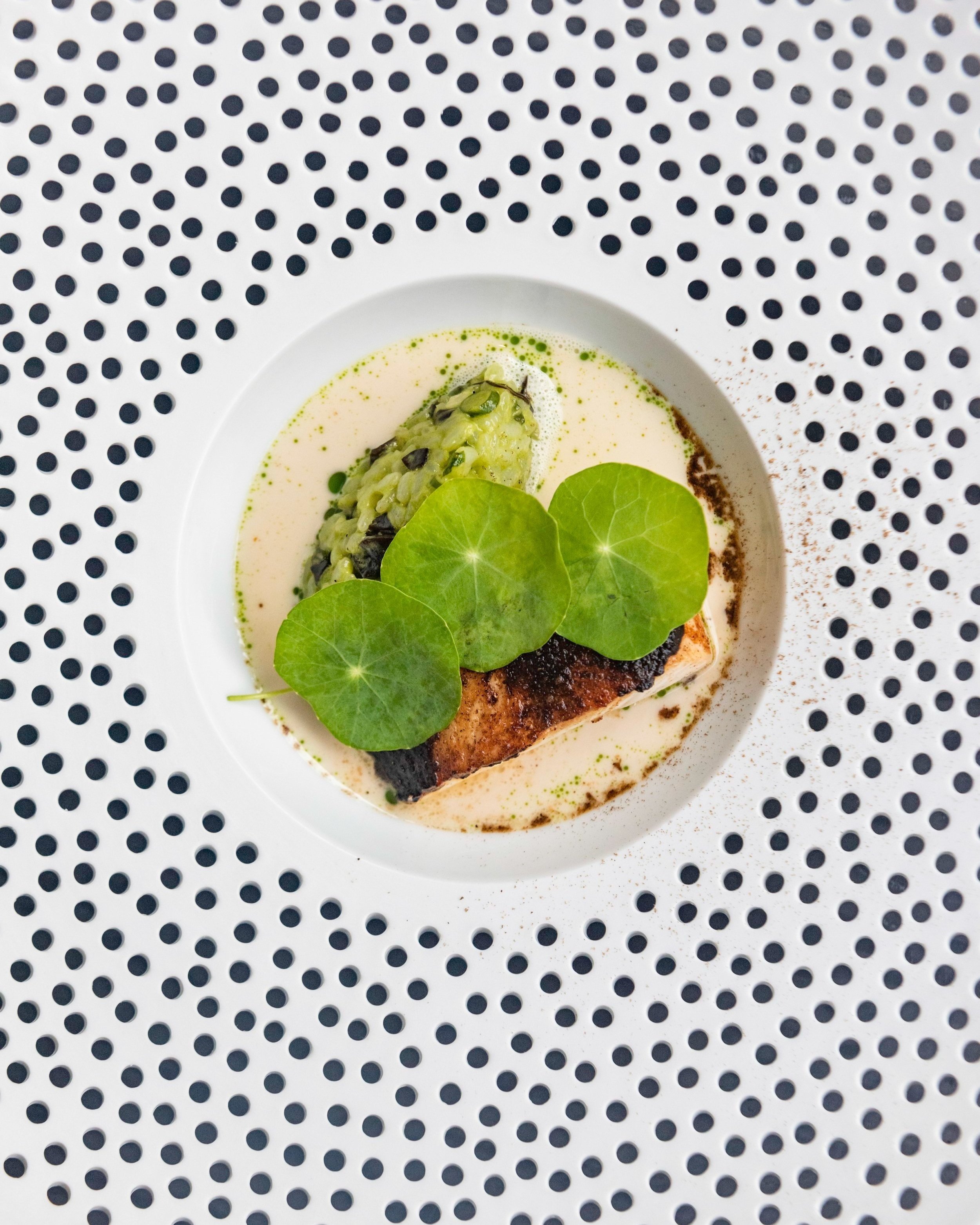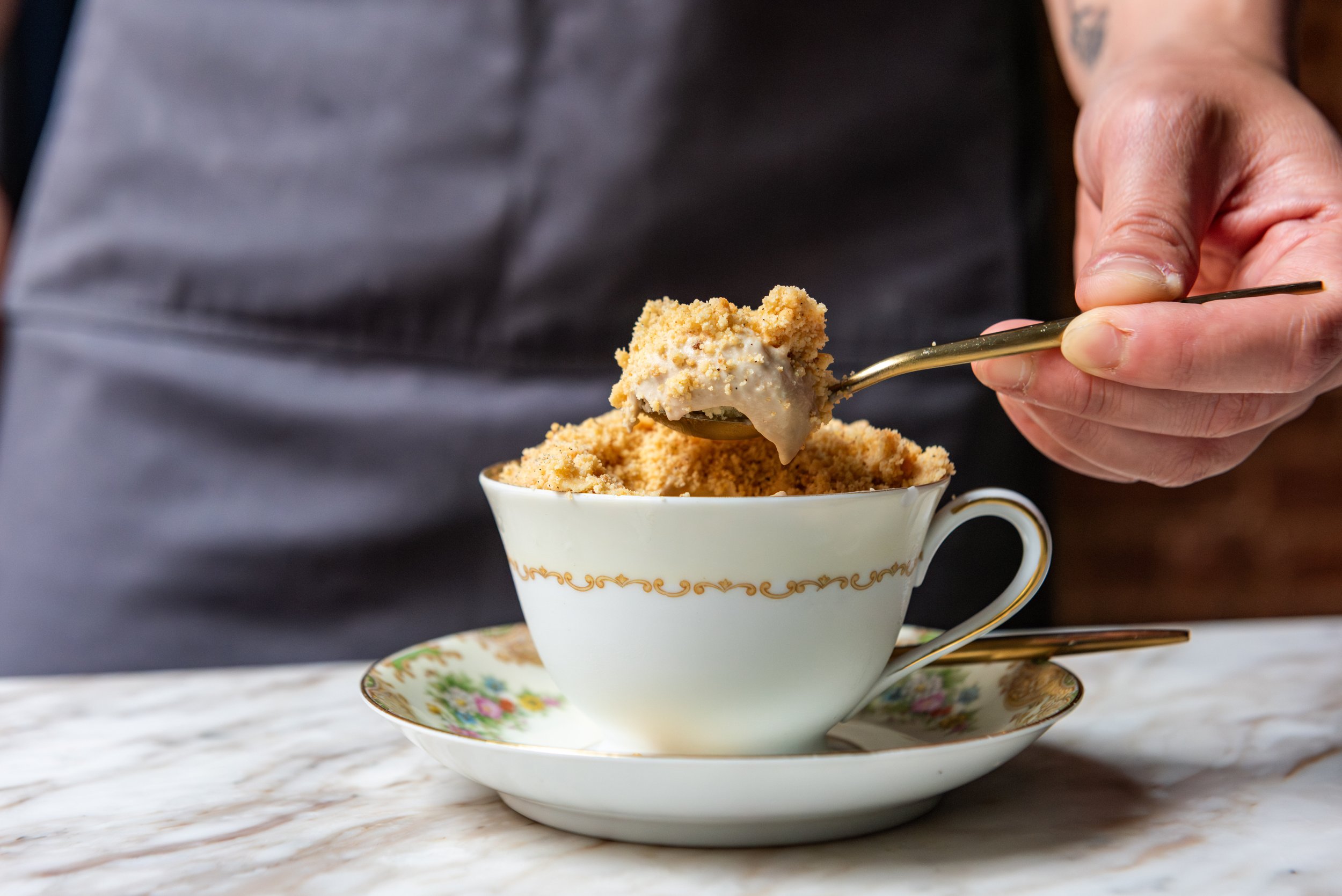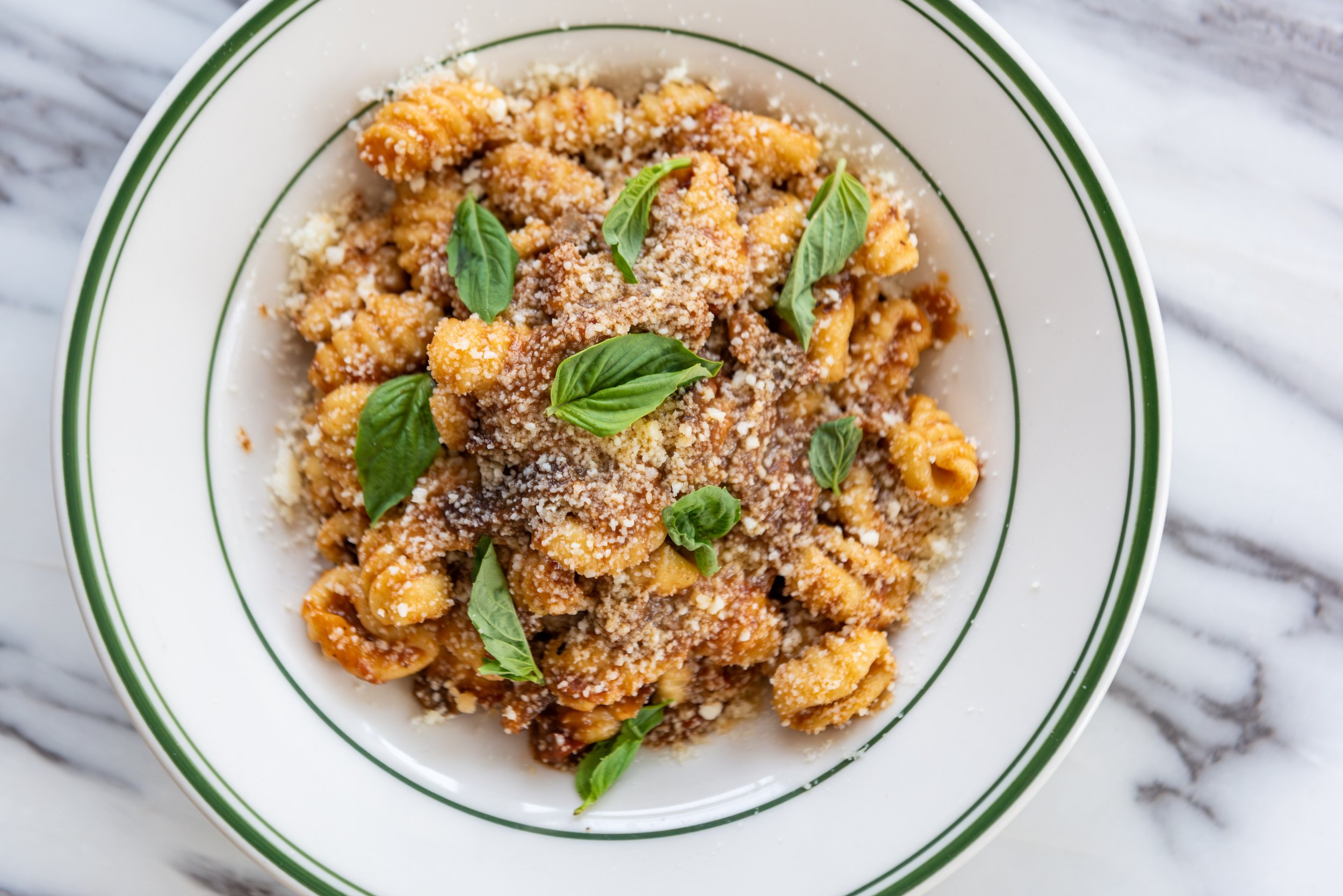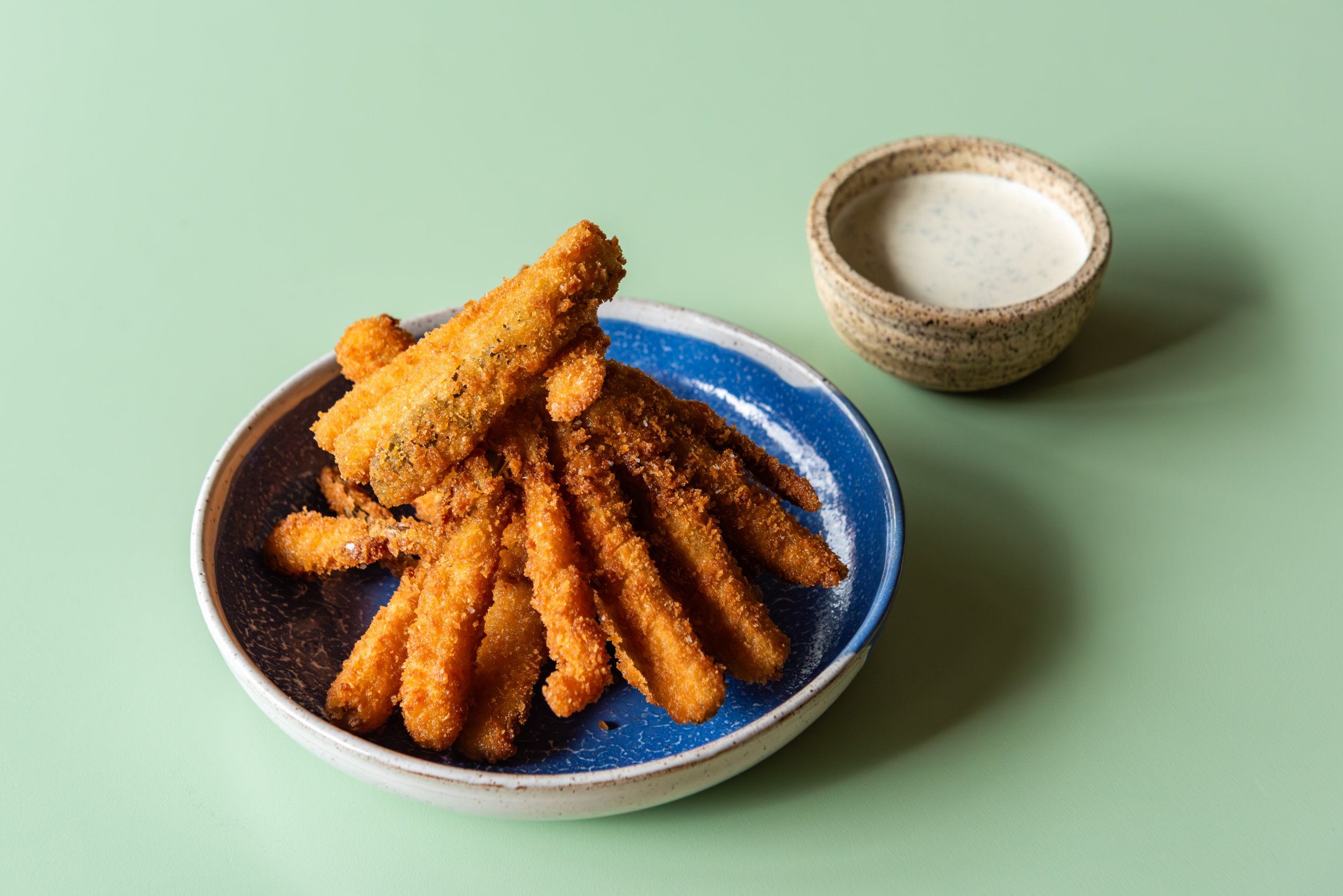2023 New York City Kitchen Notebook
An in-depth look at some of our favorite dishes and cocktails from our time on the ground in New York City.
Harvest
For Bartender Tsunetaka Imada of Angel's Share, cocktail creation is about more than what goes into the glass. Flavor, texture, and aroma are always tied together with a detailed backstory. “If [the cocktail] has some story or concept, you can think more deeply about it,” he says. While creating the Harvest, a shaken cocktail that combines lavender-infused gin, vanilla, and a grapefruit-yogurt punch, Imada envisioned an ingredient web, forging connections between components. “Roku gin features sakura,” he explains. Sakura, or cherry blossom, contains coumarin, a chemical compound that gives off a sweet scent. “Lavender has it as well,” says Imada. So, he chose to infuse dried lavender into the gin to heighten the floral aromatics. Inspired by a cocktail he had once seen in Japan that was milky-white with heavy cream and grapefruit, Imada decided to add a clarified punch of grapefruit, lemon, honey, and yogurt, with a base of Galliano. He doubles down on the vanilla notes in the liqueur by adding a few drops of a vanilla tincture. “Every ingredient has to be related,” says Imada, “it's refreshing, a little tart, and a little herbaceous—it tells a story.”
Soy-Cured Hiramasa
“My husband and parents sometimes call me a rice bucket because I can eat it for breakfast, lunch, and dinner,” says Chef Sarah Hsieh. At The Modern, Hsieh’s menu doesn’t always reflect her Chinese heritage, though she does try to utilize certain techniques and flavors. “You don’t see rice in fine dining very often, but I think it’s such a great medium.” Looking to complement and update Rising Stars alum Thomas Allan’s soy-brined, seared, and confited striped bass, Hsieh searched for a fattier fish that would play of f of the sugar in the soy brine. She swapped the striped bass for hiramasa, and paired it with a symphony of flavors and textures, including a large pile of Koshihikari rice. Hsieh seasons the heirloom rice with a bright sorrel and artichoke emulsion, sautéed wood ear mushrooms, celtuce, and shiso. The dish, in Hsieh’s words, is “delicious and comforting.” Once plated, the fish and rice are bathed in a luscious, creamy oat and artichoke broth, and finished with a small dusting of burnt citrus powder. “For me, rice equals comfort. We hope that the food [at The Modern] looks like it matches the space, but that people feel a level of comfort when they eat here.”
Vetiver Rabbit
When developing drinks at Please Don’t Tell, Bartender Sam Brooks searches far and wide for ingredients that he has either never seen before, or that aren’t typically used in cocktail making. Looking to make a vegetal highball for the bar’s late fall menu, Brooks stumbled across vetiver, a grass originally cultivated in India that is typically used in perfume and soap production. He sourced dried vetiver root and made a concentrated tea out of it. As Brooks explains, “We turn the tea into a weak syrup, which allows us to use a bit more of it than a regular syrup and get more of the vetiver flavor across.” He further boosts the vegetal characteristics of the cocktail with a cold-pressed carrot juice, green chile vodka, Strega, and cachaça. “The combination of cachaça and carrot has always felt natural to me. I remember having a carrot caipirinha when I first got into bartending, and that memory just stuck with me.” Balanced with lime and yuzu juice, Brooks’ Vetiver Rabbit is a crushable, savory highball that is accented by an overtone of grassy fragrance.
Cecina
At Aldama, Chef Gerardo Alcaraz is putting a new spin on a traditional Mexican meal he loved to eat while growing up in León, Mexico: cecina. “I always remember my hometown and my grandfather’s ranch. When we came to the ranch on the weekends, he would make cecina for everyone.” Cecina, a flattened piece of meat often served alongside guacamole and salsa cruda, takes a few days to make; it’s hung in a tree to dry in the sun to achieve a jerky-like consistency. Looking to take a new approach to the dish’s texture, Alcaraz hammers the steak paper-thin and marinates it in a simple but effective mixture of lime juice, pink peppercorns, cumin, and oregano. He dries it in the oven, and fries it to order. The result is a thin, crispy, and addictive snack that he tops with a generous spoonful of serrano chile ponzu. Alcaraz also pairs his cecina with pinto bean purée, sunchoke purée, and a spicy salsa cruda with guajillo and arbol chiles, encouraging guests to dip the chip-like cecina into the various sides. The cecina is meant to be an “ice breaker,” shared amongst the table to spark good times and good conversation—reminiscent of Alcaraz’s childhood. “In my hometown, it's a very special dish.”
Crab Key
At Sunken Harbor Club, Bartender Garret Richard expands the perception of the tiki cocktail canon by championing stirred tropical drinks. While developing the bar’s nautical-themed menu, Richard knew he wanted to highlight drinking practices from the tropics. One drink in particular stuck out to him: Scotch and coconut. “The nuttiness of coconut water plays so well with the malt in Scotch,” says Richard, “yet, it’s a relatively unknown flavor profile in the States.” Aiming to create a more concentrated version of the highball, Richard turned to an old fashioned build. He starts off by making a coconut water syrup and, to enhance the coconut flavor even further, adds Kalani coconut liqueur. To capture the essence of the coconut’s hull, Richard adds Trader Vic’s macadamia nut liqueur. Its toasted quality works harmoniously with the maltier notes of Richard’s homemade coconut oil-infused Scotch, which adds another layer of complexity without adding sweetness. “Coconut oil has its own specific flavor and smell. It gives the drink that final lift,” Richard says. Finished with a few dashes of orange bitters and garnished with a dehydrated coconut slice, the Crab Key cocktail is placed on top of a kitschy crab ashtray that delights and surprises guests.
Lon
At KRU, Chef Ohm Suansilphong fills the menu with a vibrant array of dishes that transform traditional Thai recipes, utilizing locally sourced ingredients and modern techniques. Central to the menu is a dish that is unassuming on its face, but packs a serious flavor punch. Lon (which means “simmered in coconut cream”), is a creamy and aromatic relish of sorts that marries sweet coconut with a savory protein, and is served with vegetables for dipping. “Traditionally, at every table you need at least one relish,” he says, “it stays on the table throughout the meal.” The Lon becomes the heart of the meal, acting as a palate-leveling bite amongst other dishes. For his pork jowl and prawn iteration, Suansilphong stews the meat in coconut cream with traditional fermented rice that brings texture and “sweet funkiness,” seasoned with tamarind water, galangal, fish sauce, and Thai chiles. “In the old world, you would find this everywhere, but it's getting less popular in Thailand. We wanted to blend the old school recipe with modern ingredients.” Served lukewarm alongside market-fresh vegetables and a bonus bite of fried cured fish, the dish is dynamic—creamy and refreshing, unctuous and punchy.
Watermelon Spritz
Who knew fine dining could get so... silly? If Pastry Chef Kelly Nam is snickering at the pass, you’re about to get popped (rocked). One of Nam's favorite foods growing up was hwachae; essentially Sprite with watermelon. Nam wanted to create a more sophisticated version of the Korean drink, which led her to build in similar flavors, bringing together lime curd, Champagne gelée, a delicate shiso foam, tomato meringue, candied tomato, watermelon ice cream, and a dehydrated tomato-strawberry tuile that makes for a dish glimmering with technique. A citrus dessert with pop rocks was the pastry chef’s signature during her days at Electric Lemon, so Nam wanted to carry that with her to Joomak Banjum. “I love when two people are in a serious business meeting and have to react to pop rocks in their dessert, it creates a cute moment.” The addition of pop rocks to the lime leaf sablé creates a better pop, according to Nam, and ties in the hwachae’s ‘spritz’ element. “I like to think in terms of nostalgia for my desserts, and by sneaking in pop rocks, people get a surprise."













